Did you know that SmartSeal’s commercial roof coatings can significantly extend the life of your roofing system while reducing energy costs and providing protection against harsh weather conditions? To fully reap these benefits, it’s essential to understand the application process of commercial roof coatings, from preparation to maintenance. In this guide, we will walk you through each stage, ensuring your roof remains in optimal condition for years to come.
Key Takeaways
-
- Complete a detailed roof inspection prior to application of commercial SmartSeal’s roof coatings.
-
- Choose the right coating type for your needs: Acrylic, Silicone or Polyurethane.
-
- Consider temperature, humidity and curing times when applying coating and maintain regularly with inspections & cleaning to ensure optimal performance.
Preparation for Commercial Roof Coating Application
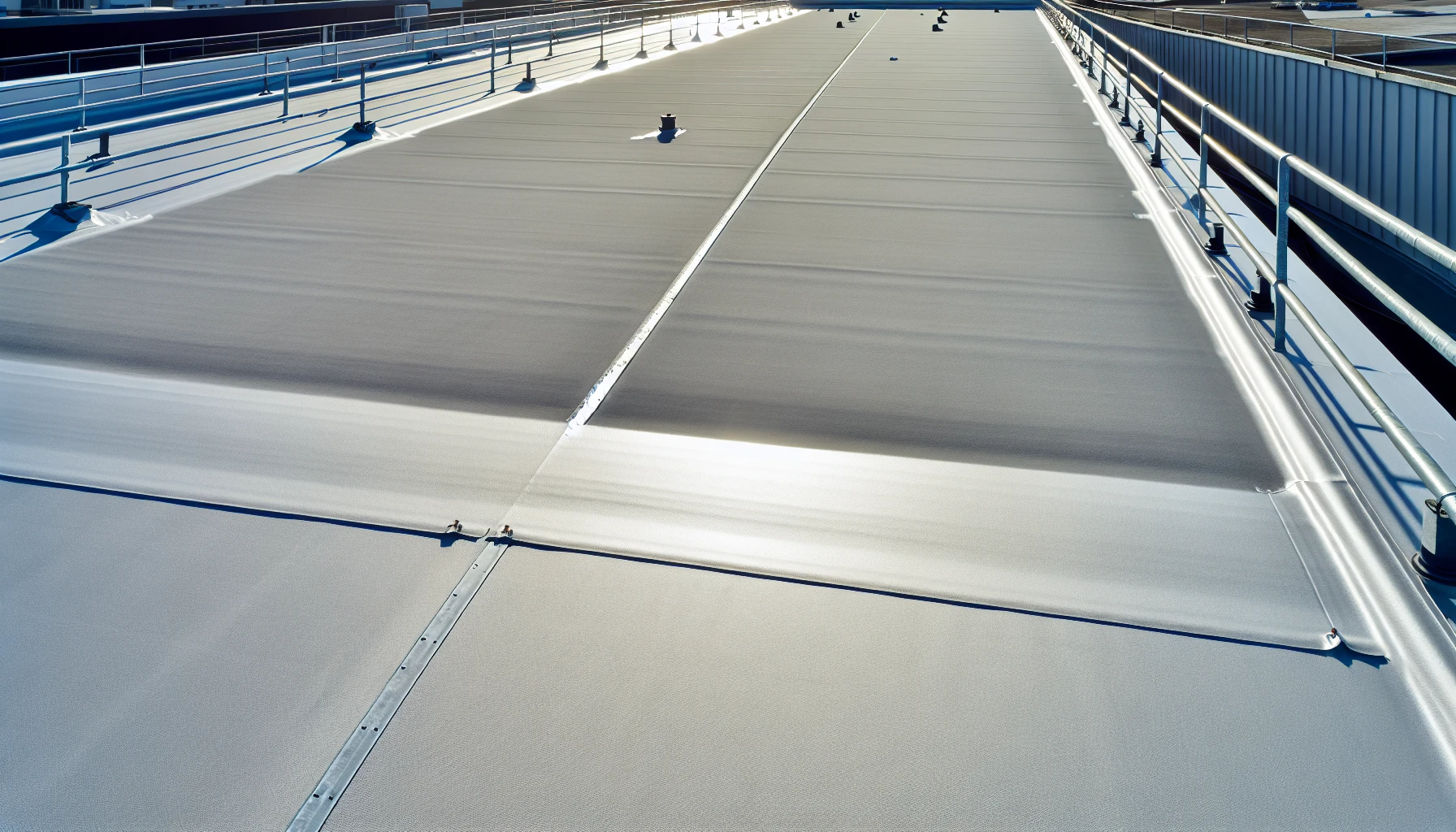
Before relishing the advantages of SmartSeal’s commercial roof coatings, appropriate preparation is necessary. This process involves a thorough roof inspection, cleaning the roof surface, and repairing any damaged areas. Skipping these steps might compromise the effectiveness of the coating and shorten its lifespan.
Roof Inspection
A detailed inspection of your existing roof is necessary to spot problems like leaks, cracks, or damaged areas that need fixing before coating application. Equipped with the proper tools, including binoculars, a ladder, a flashlight, safety harness, moisture meter, and a camera, you can thoroughly inspect your roof system and identify areas where roof sealants may be needed.
During the inspection, look for signs of leaking inside the building, examine the attic for damage, and check the roof for visible damages. If a leak is difficult to locate, you can use a garden hose to soak the area and observe for signs of water infiltration. Regular roof inspections can help you address issues early on, ensuring your roof coating remains in optimal condition.
Cleaning the Roof Surface
Cleaning the roof surface is necessary to remove dirt, debris, and contaminants that could impact the adhesion and performance of the roof coating. Some effective methods for cleaning a commercial roof surface include:
-
- Sweeping
-
- Hosing down the roof
-
- Using a high-pressure washer for built-up or graveled roofs
-
- Employing specialized equipment like leaf blowers or power washing machines
It’s important to avoid abrasive or alkaline cleaners, which can damage the roof surface. By ensuring the roof surface is clean and free of contaminants, you create an ideal environment for the commercial roof coating to adhere and provide maximum protection.
Repairing Damaged Areas
Before applying the roof coating, it is necessary to fix any damaged areas, such as cracks, blisters, or punctures in the roof membrane. Failing to repair these damages could result in the coating wearing out faster, rendering it only a temporary solution. Waterproofing porous surfaces is also vital to prevent water intrusion and ensure a seamless application of the coating.
By addressing all existing damages and properly sealing the roof surface, you create a solid foundation for the roof coating application. This will, in turn, maximize the coating’s performance and extend the life of your roof.
Choosing the Right Commercial Roof Coating
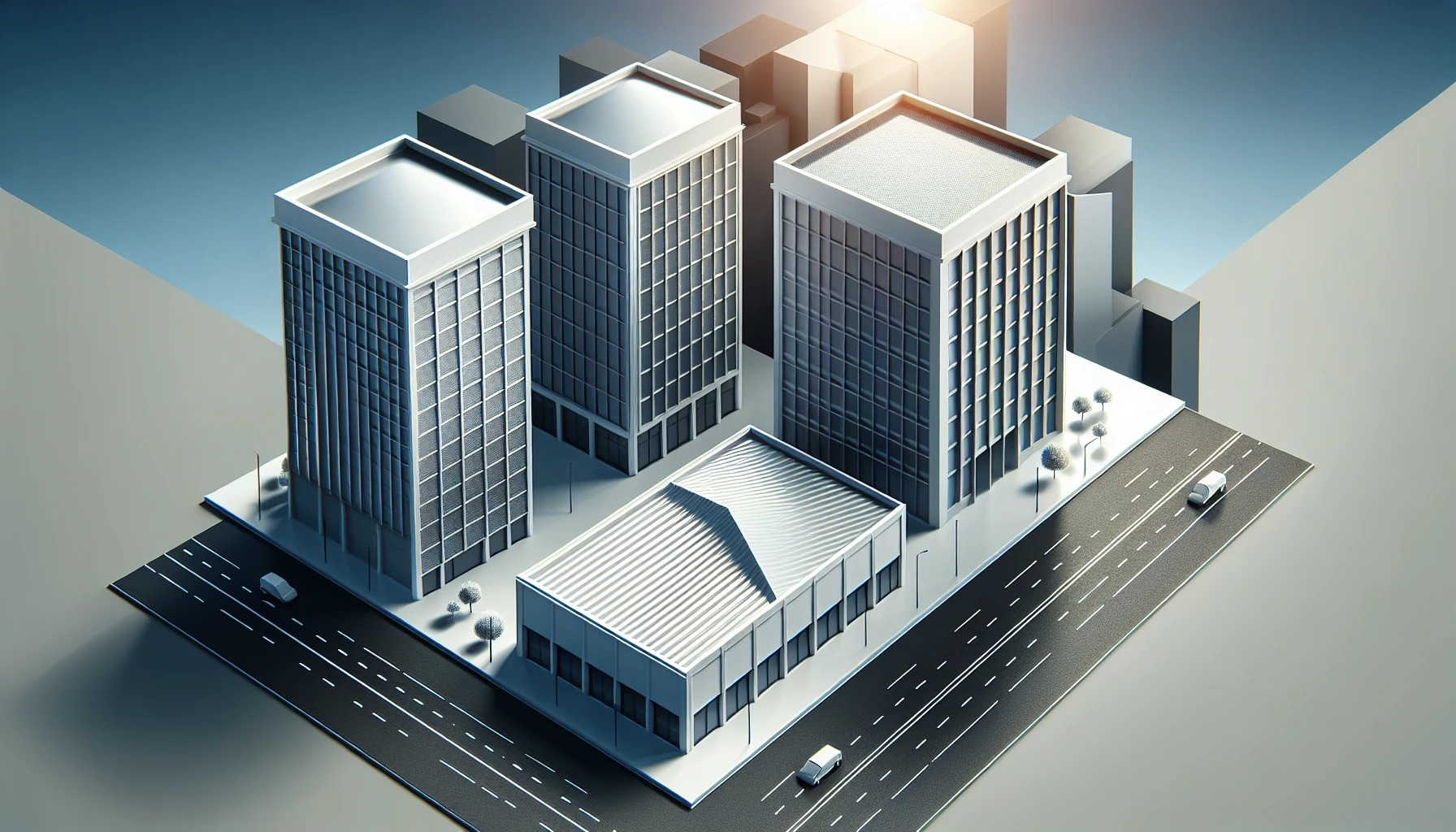
Choosing the appropriate commercial roof coating involves considering factors like the type of roof, climate, and specific requirements. The three primary types of commercial roof coatings are acrylic, silicone, and polyurethane. Each type offers distinct advantages and is suitable for various roof surfaces and conditions.
Acrylic Roof Coatings
Acrylic roof coatings, being water-based and versatile, are suitable for various roof types, including metal roofs. They offer UV resistance, energy efficiency, and are available in different colors. Elastomeric roof coating, as a type of acrylic coatings, can be applied using various methods, such as rolling, brushing, or spraying, depending on the specific roof surface.
The benefits of acrylic roof coatings include their low cost, durability, resistance to UV rays, and energy efficiency. However, their temperature range for application is limited to 50°F or higher. Moreover, it has a prolonged curing time of 7 days.
Silicone Roof Coatings
Silicone roof coatings are recognized for their superior weather resistance, waterproofing, and UV protection. They are highly resistant to ponding water, making them ideal for roofs with drainage issues. Silicone coatings can be applied using various methods, such as spraying, brushing, or rolling, and can be applied in a single layer to fill seams, cracks, or blisters on the roof surface.
While silicone roof coatings generally cost more than acrylic coatings, their remarkable waterproofing and UV protection make them well worth the investment. Regular maintenance and inspections can help ensure the longevity and performance of your silicone roof coating.
Polyurethane Roof Coatings
Polyurethane roof coatings, being solvent-based, are recognized for their excellent mechanical properties, abrasion resistance, and tensile strength. These coatings are suitable for high-stress areas and roofs with heavy foot traffic, thanks to their durability and flexibility.
In addition to their mechanical properties, polyurethane roof coatings offer the following benefits:
-
- UV protection
-
- Resistance to water penetration
-
- Reliable solution for protection against harsh weather, moisture intrusion, and potential cracking or tearing
Regular maintenance and inspections can help ensure the optimal performance of your polyurethane roof coating.
Application Techniques for Commercial Roof Coatings
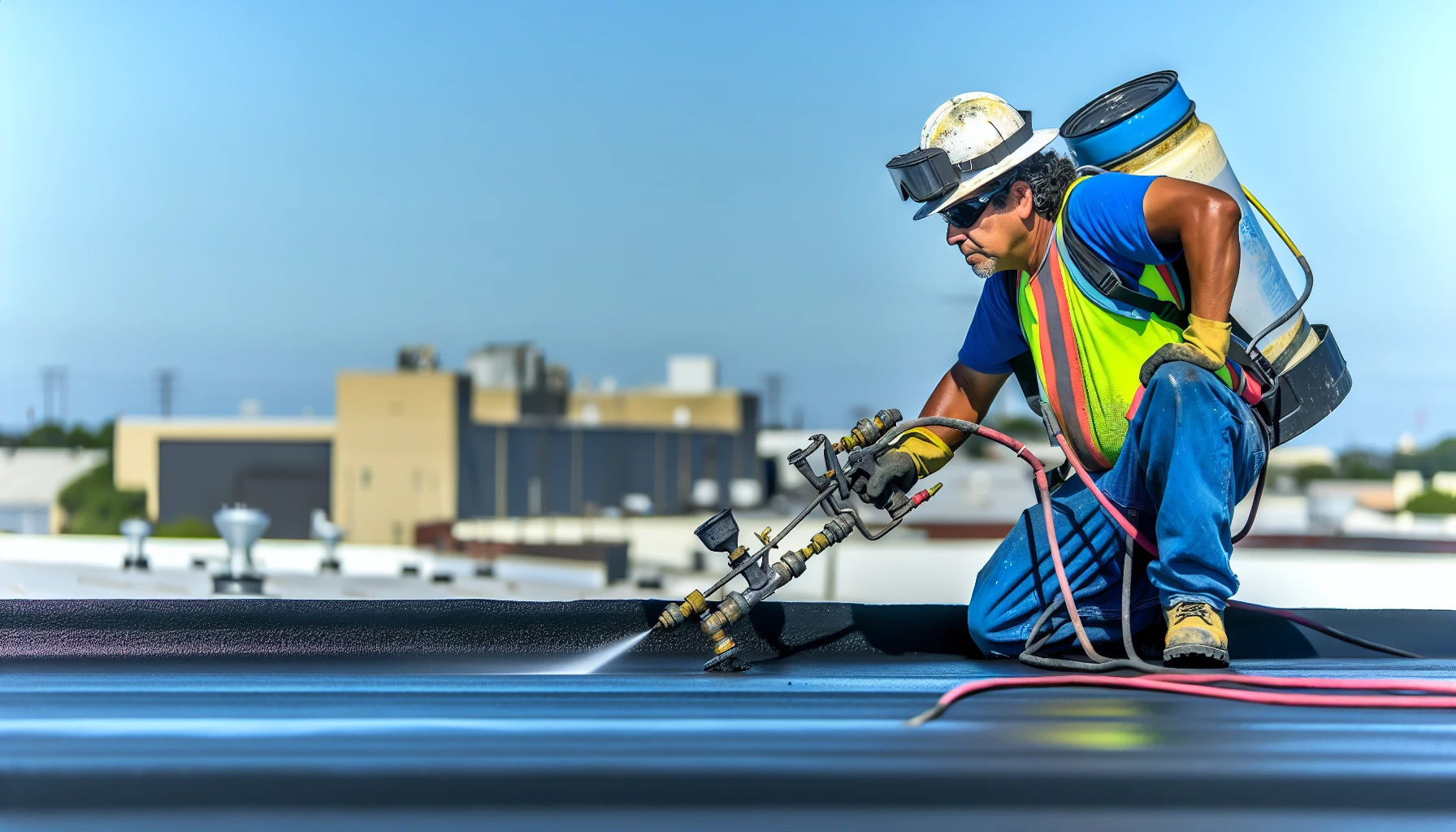
Commercial roof coatings can be applied using techniques such as spraying, rolling, and brushing, each having its own advantages and considerations. The choice of application technique will depend on factors such as the size and shape of the roof, accessibility, and the specific coating being used.
Spraying
Spraying is a quick and efficient technique for applying roof coatings, ensuring even coverage and saving labor time. Using specialized spray equipment, you can achieve a consistent and even spray pattern, providing optimal protection for your roof.
To ensure even coverage when spraying roof coatings, follow these steps:
-
- Verify the thickness of the coating material being applied.
-
- Backroll the coating for better adhesion.
-
- Properly plan the application.
-
- Apply the coating in warm, dry conditions.
Following these steps will contribute to a successful spraying application.
Rolling
Rolling is an appropriate technique for smaller roofs, including low slope roofs, or areas with limited access, offering exact control over the application thickness. While rolling is a slower process than spraying, it can result in a thicker surface, ensuring maximum protection for your roofing system.
When rolling commercial roof coatings, it’s important to adhere to the manufacturer’s specifications for the particular coating being used and ensure the coating is applied evenly across the entire roof surface. Regular maintenance and inspections can help guarantee the longevity and performance of your rolled roof coating.
Brushing
Brushing is perfect for detailed work, such as around penetrations, seams, and edges, guaranteeing proper adhesion and coverage in these critical areas. Using a stiff paintbrush and long, even strokes, you can apply the roof coating with precision and avoid drips or uneven coverage.
By ensuring the coating is applied evenly around penetrations, seams, and edges, you create an ideal environment for the commercial roof coating to adhere and provide maximum protection. Regular maintenance and inspections can help ensure the longevity and performance of your brushed roof coating.
Weather Considerations and Timing
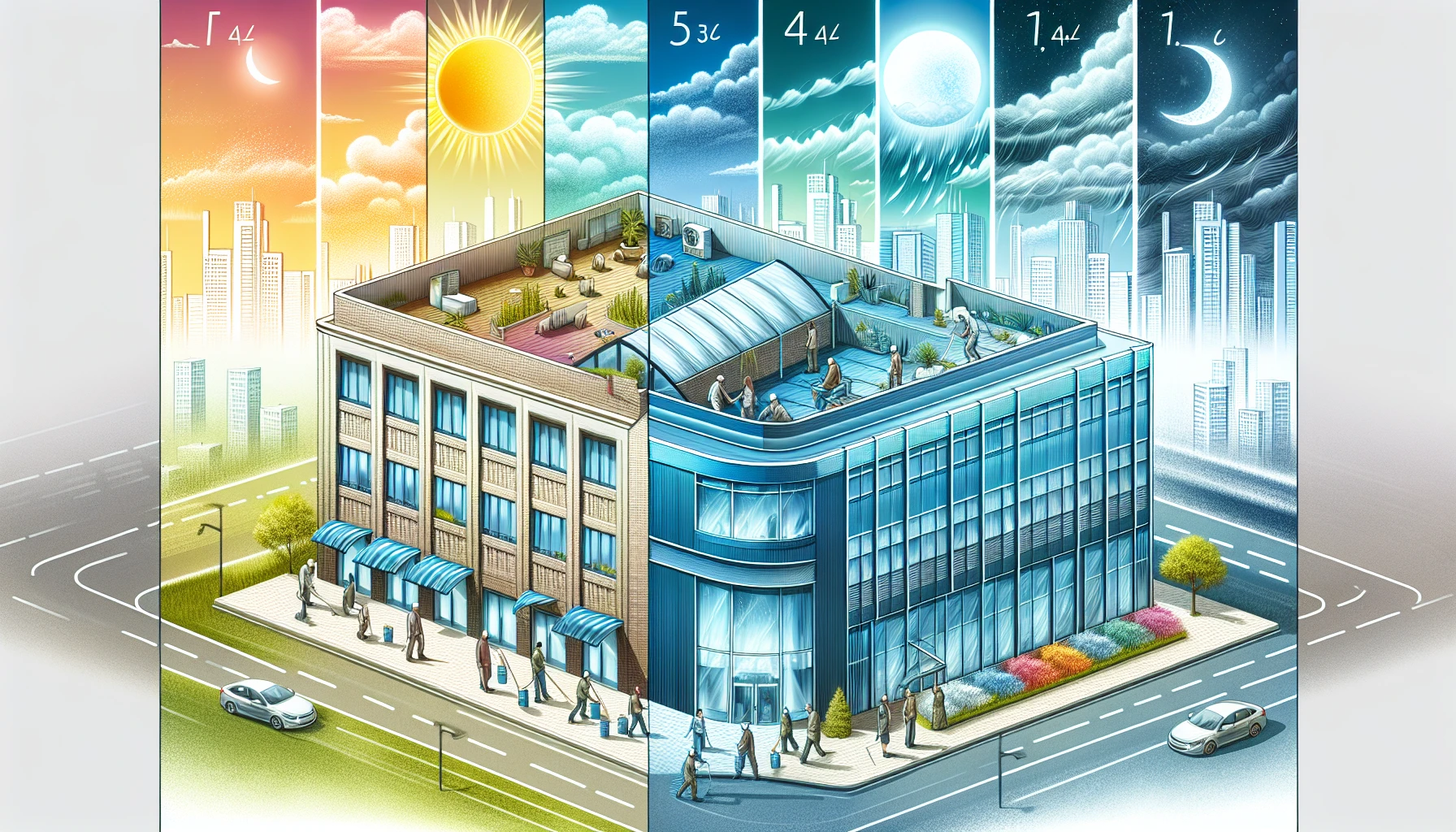
Weather considerations and timing are critical for a successful roof coating application, including factors like temperature, humidity, and drying/curing time. The ideal conditions for applying a commercial roof coating are warm, dry weather, with temperatures above 50°F (10°C) and increasing.
Temperature and Humidity
Temperature and humidity significantly impact the application process, as they can influence the adhesion, curing, and overall performance of the roof coating. The recommended temperature range for the application of commercial roof coatings is generally above 50°F (10°C) and increasing, while the optimal humidity lies within the range of 40-60%.
Extreme cold temperatures can have a detrimental effect on the application and performance of commercial roof coatings, as they can cause roofing materials to become more rigid and prone to cracking. Therefore, it’s essential to apply roof coatings within the recommended temperature range for optimal adhesion and performance.
Drying and Curing Time
Drying and curing time differs depending on the coating type and weather conditions. It is essential to allow sufficient time between coats and before exposing the roof to foot traffic or harsh weather, to ensure the coating has fully cured and is able to resist the elements.
For instance, the average drying and curing time for acrylic roof coatings is generally around 4 hours, but it’s advisable to consult the instructions provided by the specific brand, as drying and curing times may vary. By considering the drying and curing time, you can ensure a successful application and optimal roof coating performance.
Maintenance and Recoating
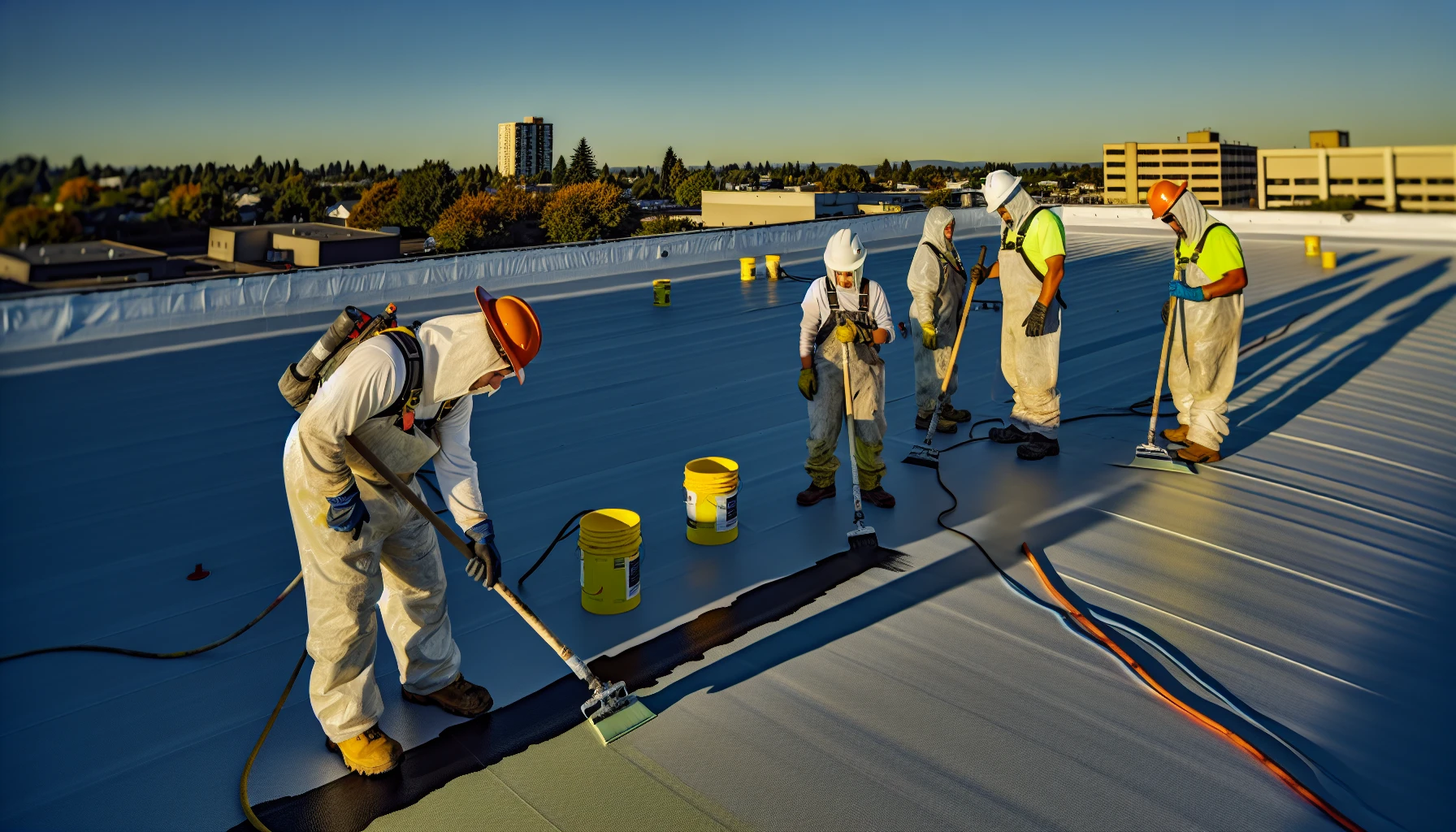
Maintenance and recoating are key to extending the lifespan and performance of commercial roof coatings. Here are some steps to follow:
-
- Conduct regular inspections to identify any issues early on.
-
- Clean the roof coating regularly to remove dirt and debris.
-
- Address any issues promptly to ensure the coating remains in optimal condition.
By following these steps, you can ensure the longevity and effectiveness of your commercial roof coating.
Regular Inspections and Cleaning
Regular inspections aid in assessing the condition of your coated commercial roof and detecting any potential problems that require attention. By cleaning your roof routinely, you can extend its lifespan, minimize maintenance requirements, and increase energy efficiency.
The frequency of commercial roof inspections can vary based on weather conditions and the type of roof, but it is typically suggested to conduct inspections twice a year, usually in the spring and fall before storm seasons. Regular inspections and cleaning can help ensure the roof coating remains in optimal condition and protect your investment.
Recoating Schedule
Recoating schedules are dependent on factors such as the coating type, climate, and roof usage. Generally, recoating should be done every 10-20 years to maintain the roof’s performance and protection. Regular maintenance and inspections can help determine the ideal timing for recoating.
For example, acrylic roof coatings should be recoated every 10 to 20 years, while silicone roof coatings might require recoating every 10 to 15 years. By following a recoating schedule and maintaining your roof coating, you can preserve the life of your roof and ensure optimal performance.
Summary
In conclusion, commercial roof coatings offer numerous benefits, including extended roof life, energy efficiency, and protection against harsh weather conditions. By following this step-by-step guide, from preparation to maintenance, you can ensure the successful application of a commercial roof coating and enjoy the long-term advantages it provides.
Remember, the key to a successful roof coating application lies in proper preparation, choosing the right coating, applying it with the appropriate technique, and conducting regular maintenance and recoating. By doing so, you’ll be investing in the longevity and performance of your roof, safeguarding your building, and saving on energy costs.
Frequently Asked Questions
How do you install roof coating?
To install a rubber roof coating, create a plan, select the proper clothing, clean the roof, repair any damage, apply a base coat and top coat, then finally apply the coating.
What are the layers of roof coating?
The most common layers of roof coating are tar or tar paper, rolled asphalt sheeting, or polyester fabric, covered by several coats of liquid rubber (elastomeric/cool coat).
What is a commercial roof coating?
A commercial roof coating is a fluid applied across the membrane of your roofing system, designed to extend its service life by protecting it from leaks, sun damage and ponding water.
What is the purpose of a roof inspection prior to the application of commercial roof coating?
A roof inspection prior to applying commercial roof coating is essential in order to identify any existing issues that must be addressed before the application.
What are the three primary types of commercial roof coatings?
The three primary types of commercial roof coatings are acrylic, silicone, and polyurethane.




